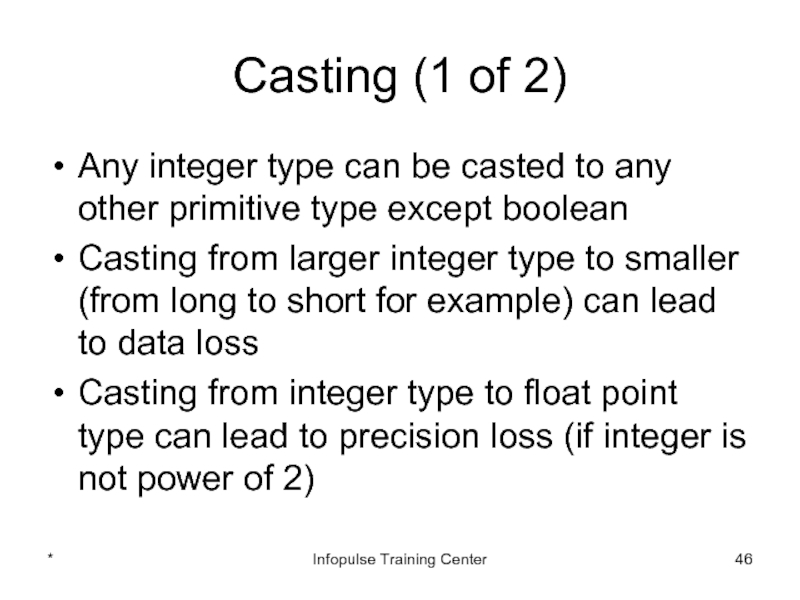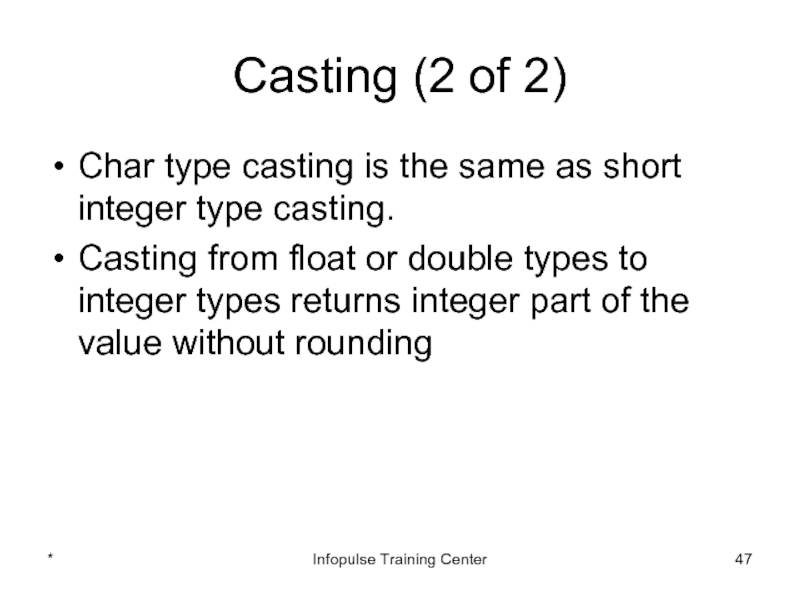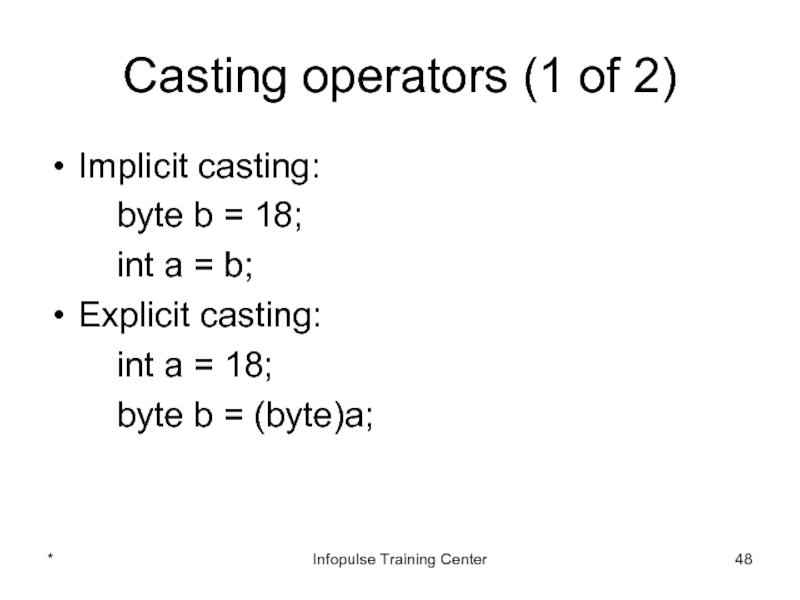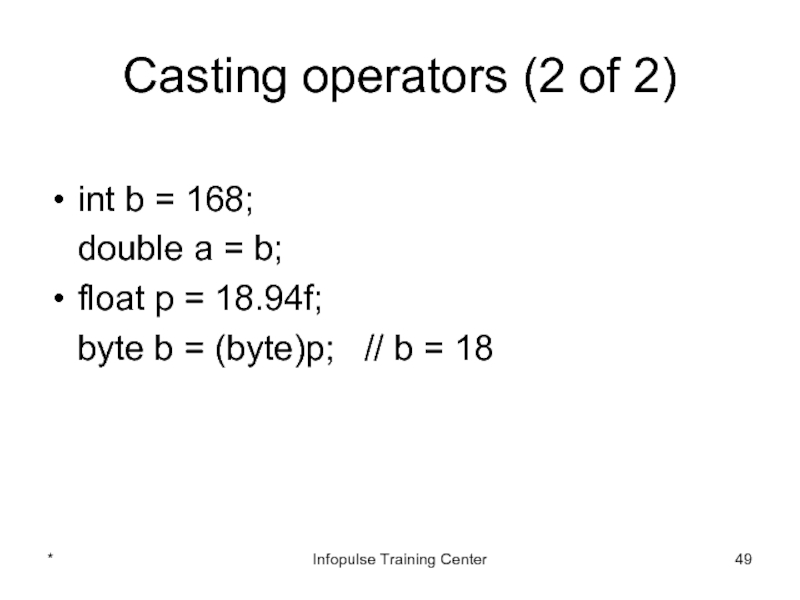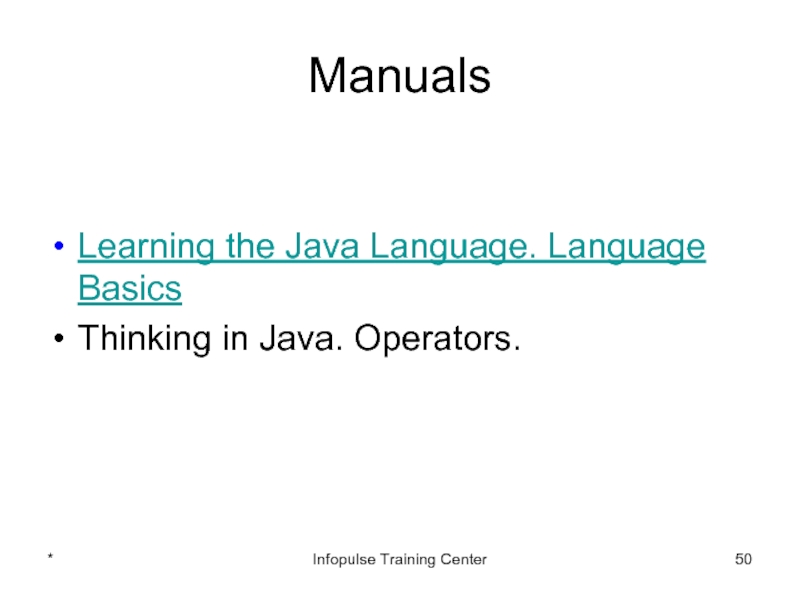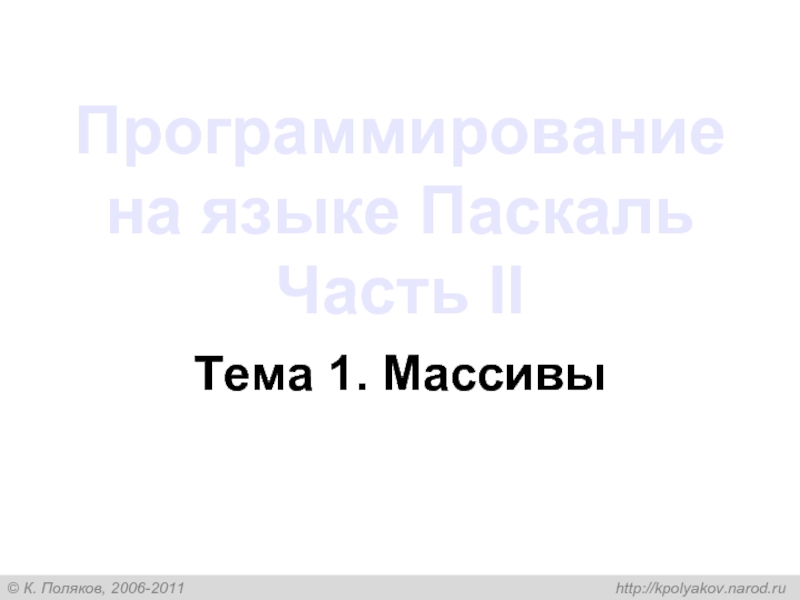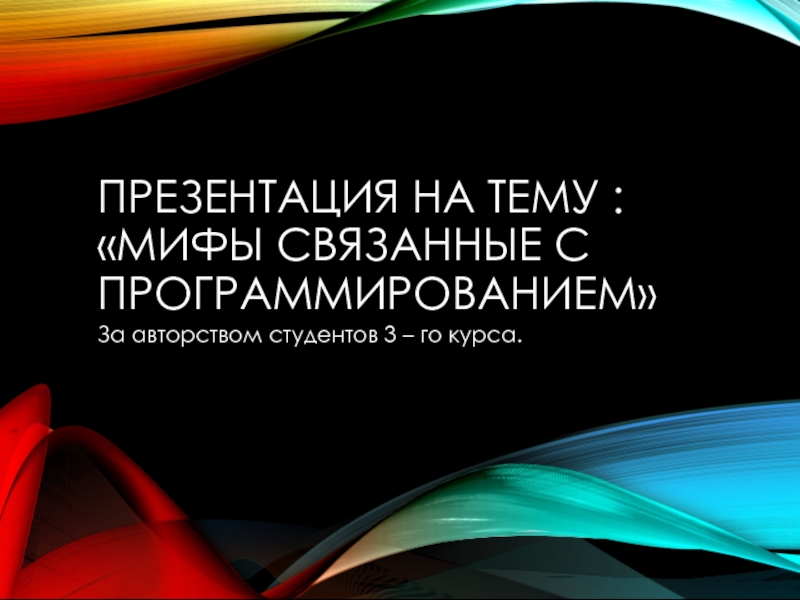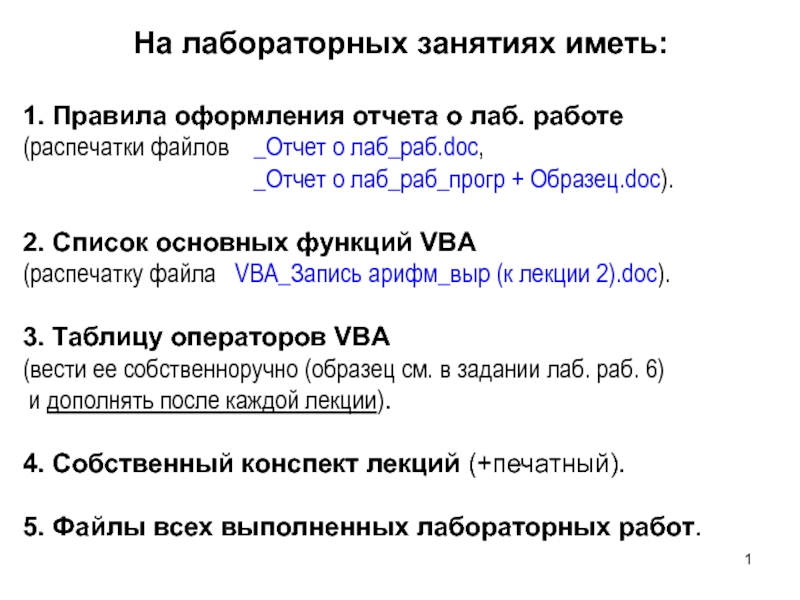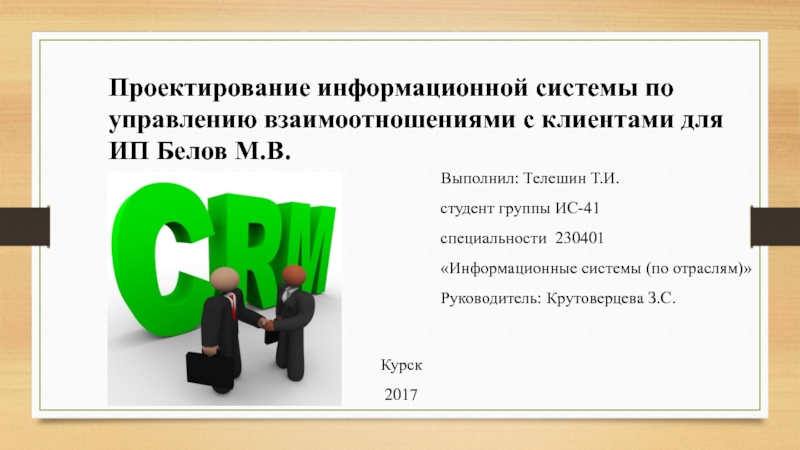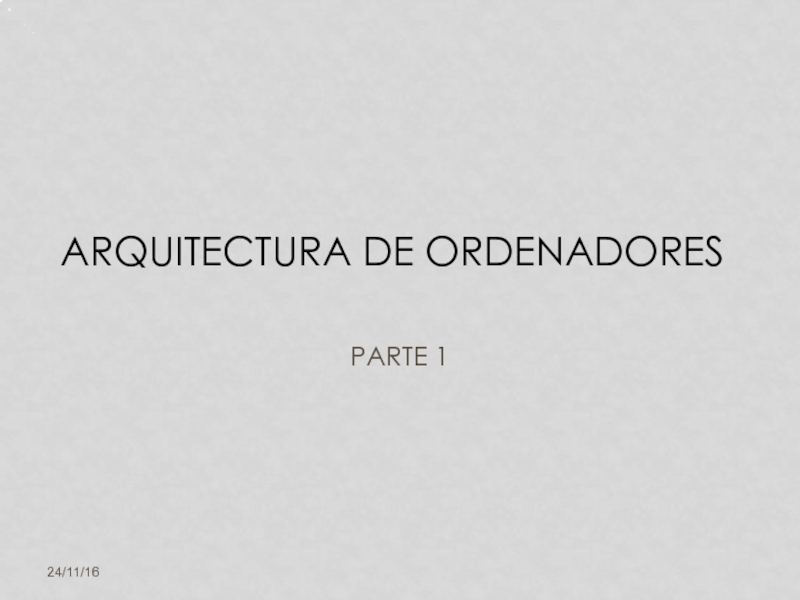- Главная
- Разное
- Дизайн
- Бизнес и предпринимательство
- Аналитика
- Образование
- Развлечения
- Красота и здоровье
- Финансы
- Государство
- Путешествия
- Спорт
- Недвижимость
- Армия
- Графика
- Культурология
- Еда и кулинария
- Лингвистика
- Английский язык
- Астрономия
- Алгебра
- Биология
- География
- Детские презентации
- Информатика
- История
- Литература
- Маркетинг
- Математика
- Медицина
- Менеджмент
- Музыка
- МХК
- Немецкий язык
- ОБЖ
- Обществознание
- Окружающий мир
- Педагогика
- Русский язык
- Технология
- Физика
- Философия
- Химия
- Шаблоны, картинки для презентаций
- Экология
- Экономика
- Юриспруденция
2. Java Basics. Data Types презентация
Содержание
- 1. 2. Java Basics. Data Types
- 2. Java Data Types Primitive Boolean Numeric Integer
- 3. Boolean Type Type boolean Two possible values:
- 4. Boolean Operators =
- 5. If-Then-Else Boolean Operator expression1 ? expression2 :
- 6. AND Boolean Operator 1. boolean a =
- 7. AND Boolean Operator 1. boolean a =
- 8. Integer Types * Infopulse Training Center All
- 9. Integer Literals Decimal constant should start with
- 10. Integer Arithmetic Operations + add - subtract * multiply / divide % get reminder * Infopulse Training Center
- 11. Integer Addition byte a = 120; byte
- 12. Integer Arithmetic Operations If one operand has
- 13. Integer Assignment The integer assignment performs implicit
- 14. Java Overflow And Underflow In Java arithmetic
- 15. The Overflow Problem In Java arithmetic overflow
- 16. Integer Division x = a / b
- 17. Integer Division Division by 0 leads to
- 18. The Integer Unary Operators + Unary plus operator
- 19. What will be a value? int x
- 20. What will be done? int c =
- 21. What will be done? int c =
- 22. Bitwise Operators ~ inverts a bit & bitwise
- 23. Bitwise Operators int a = 45; int
- 24. Bit Shift Operators > signed right shift operator
- 25. Bit Shift Operators int a = 45;
- 26. Integer Assignment Operators = +=, -=, *=,
- 27. Integer Assignment Operators x += 1; instead
- 28. The Equality and Relational Operators == equal
- 29. Float point Data Types float – 32
- 30. Float point Arithmetic Operations + add - subtract * multiply / divide * Infopulse Training Center
- 31. Float point Arithmetic Operations If one operand
- 32. What will be c and d value?
- 33. Special Float Point Values -Infinity +Infinity NaN
- 34. Precision Problem I double a = 2.0;
- 35. Precision Problem II How many repetitions will
- 36. Debugging in Eclipse Start debugging: press Debug
- 37. Precision Problem Source Above precision problems caused
- 38. Float point Literals Here are possible formats
- 39. The Float point Unary Operators + Unary plus
- 40. Float point Assignment Operators = +=, -=, *=, /= * Infopulse Training Center
- 41. The Equality and Relational Operators == equal
- 42. Char Type The char data type is
- 43. Char Literals A symbol: 'a', 'A', '9',
- 44. Char Examples char c = 'g'; System.out.println(++c);
- 45. Expressions. Operator precedence .
- 46. Casting (1 of 2) Any integer type
- 47. Casting (2 of 2) Char type casting
- 48. Casting operators (1 of 2) Implicit
- 49. Casting operators (2 of 2) int
- 50. Manuals Learning the Java Language. Language Basics
Слайд 2Java Data Types
Primitive
Boolean
Numeric
Integer
Float-point
Char
Reference
Array
Class
Interface
*
Infopulse Training Center
Слайд 3Boolean Type
Type boolean
Two possible values: true, false
Use this data type for
Not compatible with other types (integer!)
Even explicit cast is impossible
Its "size" isn't something that's precisely defined
*
Infopulse Training Center
Слайд 4Boolean Operators
= assignment
== !=
! NOT
&& AND
|| OR
?: if-then-else
& bitwise AND
| bitwise OR
*
Infopulse Training Center
Слайд 5If-Then-Else Boolean Operator
expression1 ? expression2 : expression3
Examples:
BestReturn = Stocks > Bonds
LowSales = JuneSales < JulySales ? JuneSales : JulySales;
Distance = Site1 - Site2 > 0 ? Site1 - Site2 : Site2 - Site1;
*
Infopulse Training Center
Слайд 6AND Boolean Operator
1. boolean a = false;
2. boolean b = true;
3.
4. boolean d = a & b;
Will we get the same results for c and d?
*
Infopulse Training Center
Слайд 7AND Boolean Operator
1. boolean a = false;
2. boolean b = true;
3.
Operation && calculates first operand. If it equals false, then returns false without second operand calculation
4. boolean d = a & b;
Operation & calculates both operands and then returns the result
*
Infopulse Training Center
Слайд 8Integer Types
*
Infopulse Training Center
All integer type are singed integer types
long is
int is approximately in interval -2E9 to 2E9
Слайд 9Integer Literals
Decimal constant should start with nonzero digit
Leading zero means octal
Leading 0x means hexadecimal constant (you can use A-F or a-f as digits)
Long constant ends with L or l symbols.
Any number of underscore characters (_) can appear anywhere between digits in a numerical constants (since Java 7 only!)
*
Infopulse Training Center
Слайд 10Integer Arithmetic Operations
+ add
- subtract
* multiply
/ divide
% get reminder
*
Infopulse Training Center
Слайд 11Integer Addition
byte a = 120;
byte b = 10;
byte c = (byte)(a
What will be c value?
Why we use (byte)(a + b)?
*
Infopulse Training Center
Слайд 12Integer Arithmetic Operations
If one operand has long type then other operand
The result of an operation has int type if it value does not need long type.
*
Infopulse Training Center
Слайд 13Integer Assignment
The integer assignment performs implicit type conversion if neither accuracy
If implicit cast is impossible then explicit cast is needed, otherwise compilation error will occur ( e.g byte = (byte)int )
*
Infopulse Training Center
Слайд 14Java Overflow And Underflow
In Java arithmetic operators don’t report overflow and
When the result of an arithmetic integer operation is larger than 32 bits then the low 32 bits only taken into consideration and the high order bits are discarded
The same with long type (64 bits)
It’s a shame of Java
*
Infopulse Training Center
Слайд 15The Overflow Problem
In Java arithmetic overflow will never throw an exception
long
long b = 2L;
long c = a + b;
c = -9223372036854775808L
*
Infopulse Training Center
Слайд 16Integer Division
x = a / b
r = a % b
int a
int b = 3;
int c = a / b;
int d = a % b;
What will be c and d values?
*
Infopulse Training Center
Слайд 17Integer Division
Division by 0 leads to runtime ArithmeticException:
int a = 5;
int
int c = a / b;
*
Infopulse Training Center
Слайд 18The Integer Unary Operators
+ Unary plus operator
- Unary minus operator
++ Increment operator
-- Decrement operator
For pre-increment
For post-increment and post-decrement (i.e., a++ or a--), the value is produced, then the operation is performed.
*
Infopulse Training Center
Слайд 22Bitwise Operators
~ inverts a bit
& bitwise AND
| bitwise OR
^ bitwise inclusive OR
*
Infopulse
Слайд 23Bitwise Operators
int a = 45;
int b = 34;
int c = a
What will be c value?
int d = c ^ b;
What will be d value?
*
Infopulse Training Center
Слайд 24Bit Shift Operators
> signed right shift operator
>>> right
*
Infopulse Training Center
Слайд 25Bit Shift Operators
int a = 45;
int b = a >> 3;
b = ?
int c = a << 3;
c = ?
*
Infopulse Training Center
Слайд 27Integer Assignment Operators
x += 1; instead x = x + 1;
a
*
Infopulse Training Center
Слайд 28The Equality and Relational Operators
== equal to
!= not equal to
> greater than
>= greater than or equal to
< less than
<= less than or equal to
*
Infopulse Training Center
Слайд 29Float point Data Types
float – 32 bit (±
double – 64 bit (± 1E308, 16-17 dec. precision)
Accordingly IEEE 754-1985 standard
*
Infopulse Training Center
Слайд 30Float point Arithmetic Operations
+ add
- subtract
* multiply
/ divide
*
Infopulse Training Center
Слайд 31Float point Arithmetic Operations
If one operand has double type then other
If one operand has float type and other operand has any type differs from double then other operand is converted to float and result will be float type
*
Infopulse Training Center
Слайд 32What will be c and d value?
double a = 2.2;
double b
a = a - 2.2;
double c = b / a;
double d = Math.sqrt(b);
*
Infopulse Training Center
Слайд 33Special Float Point Values
-Infinity
+Infinity
NaN
In previous code c = -Infinity, d =
*
Infopulse Training Center
Слайд 34Precision Problem I
double a = 2.0;
double b = a - 1.1;
b
*
Infopulse Training Center
Слайд 35Precision Problem II
How many repetitions will be?
double d = 0.1;
while (d
System.out.println(d);
d += 0.1;
}
*
Infopulse Training Center
Слайд 36Debugging in Eclipse
Start debugging: press Debug icon and use F6 key
Use Cntr + Shift + B for breakpoint creation
Use Cntr + R to run application to the next breakpoint
*
Infopulse Training Center
Слайд 37Precision Problem Source
Above precision problems caused by the
fact that finite
periodical binary fraction:
So 0.1 can be represented as binary fraction
in a computer only approximately.
*
Infopulse Training Center
Слайд 38Float point Literals
Here are possible formats for float point constants
1003.45
.00100345e6
100.345E+1
100345e-2
1.00345e3
0.00100345e+6
Suffix f(F) means float constant, suffix d(D) – double constant. Constant without suffix - double
*
Infopulse Training Center
Слайд 39The Float point Unary Operators
+ Unary plus operator
- Unary minus operator
++ Increment operator
-- Decrement operator
*
Infopulse
Слайд 41The Equality and Relational Operators
== equal to
!= not equal to
> greater than
>= greater than or equal to
< less than
<= less than or equal to
*
Infopulse Training Center
Слайд 42Char Type
The char data type is a single 16-bit Unicode character
Char
*
Infopulse Training Center
Слайд 43Char Literals
A symbol: 'a', 'A', '9', '+', '_', '~' (except \)
Unicode
Escape sequences '\b' '\t' '\n' '\f' '\r' '\"' '\'' '\\'
Don’t confuse char and string literals (e.g. ‘r’ and “r”)!
The \uxxxx notation can be used anywhere in the source to represent unicode characters
*
Infopulse Training Center
Слайд 44Char Examples
char c = 'g';
System.out.println(++c);
char r = (char)(c ^ 32);
*
Infopulse Training
Слайд 45Expressions.
Operator precedence
. [] ()
+ -
* / %
+ -
<< >> >>>
< <= >= >
== !=
&
^
|
&&
||
?:
= op=
*
Infopulse Training Center
Слайд 46Casting (1 of 2)
Any integer type can be casted to any
Casting from larger integer type to smaller (from long to short for example) can lead to data loss
Casting from integer type to float point type can lead to precision loss (if integer is not power of 2)
*
Infopulse Training Center
Слайд 47Casting (2 of 2)
Char type casting is the same as short
Casting from float or double types to integer types returns integer part of the value without rounding
*
Infopulse Training Center
Слайд 48Casting operators (1 of 2)
Implicit casting:
byte
int a = b;
Explicit casting:
int a = 18;
byte b = (byte)a;
*
Infopulse Training Center
Слайд 49Casting operators (2 of 2)
int b = 168;
double
float p = 18.94f;
byte b = (byte)p; // b = 18
*
Infopulse Training Center
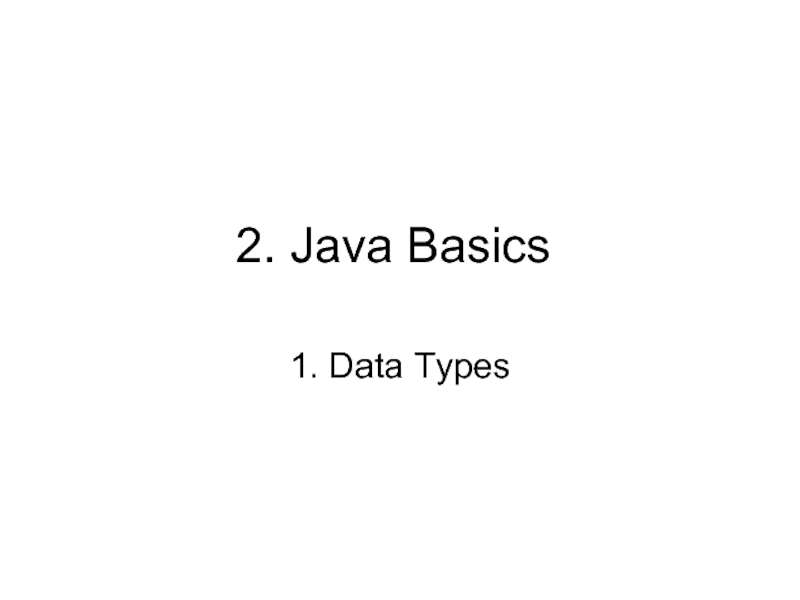
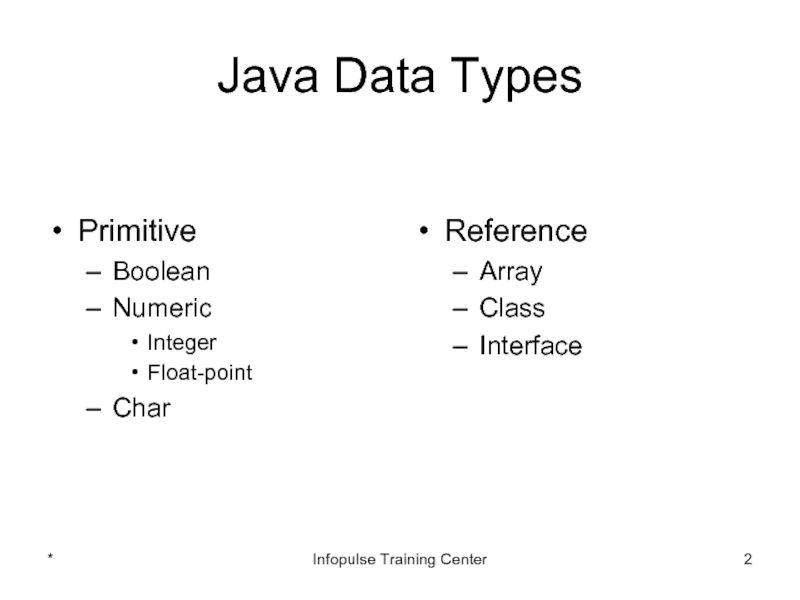
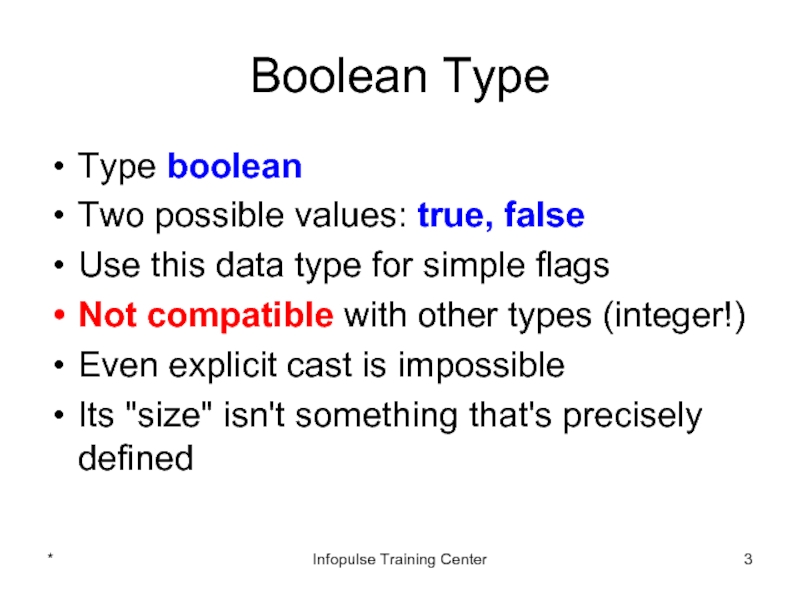
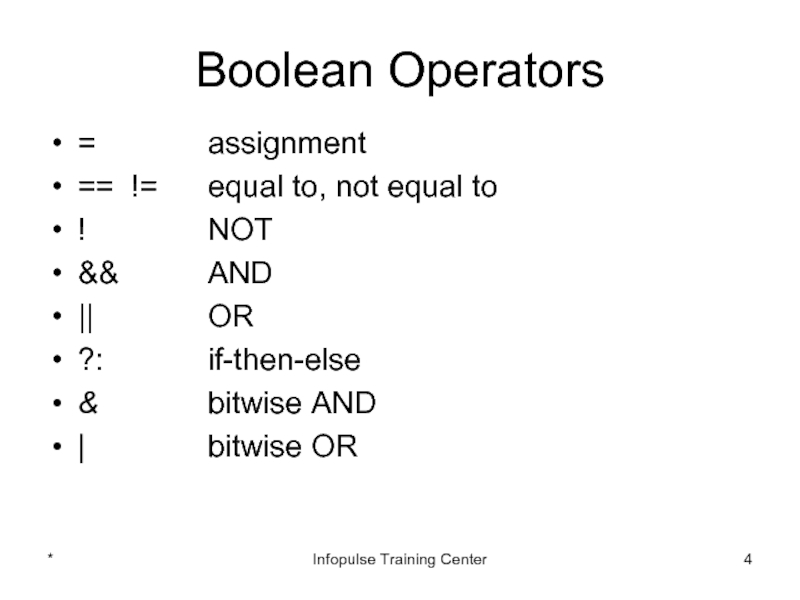
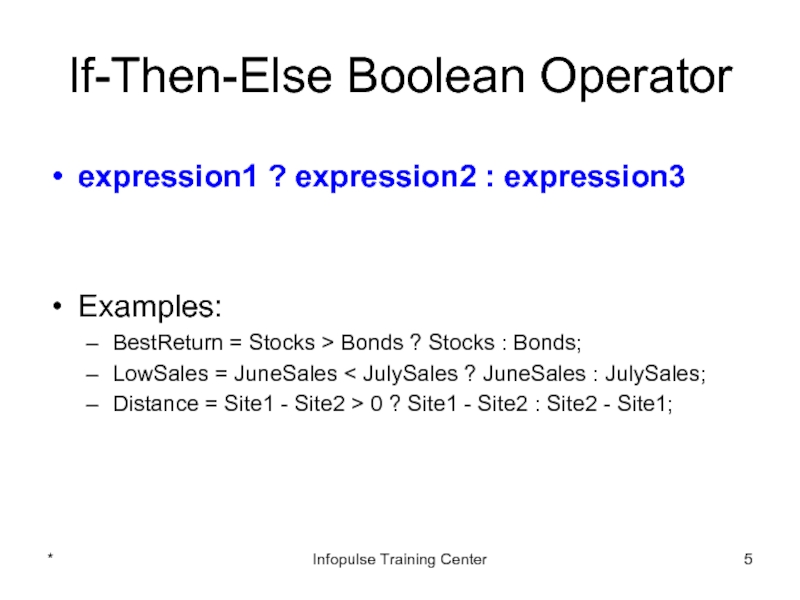

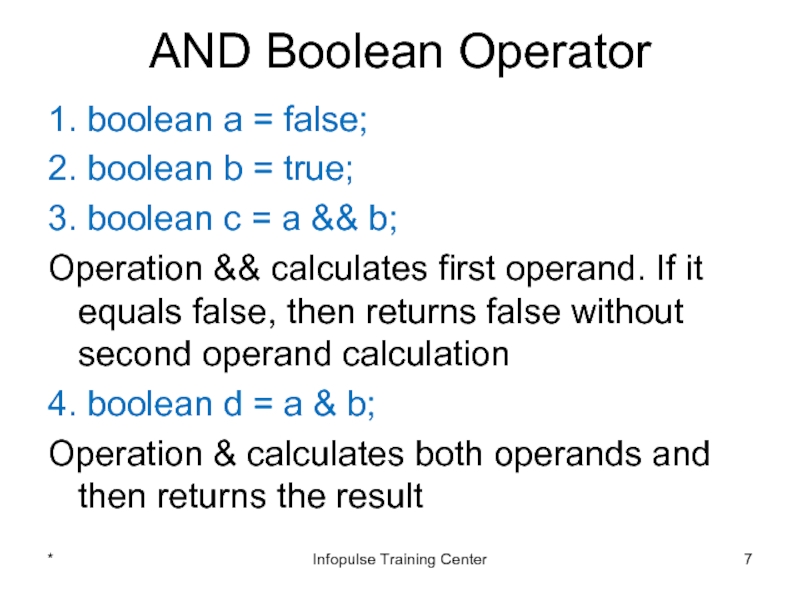
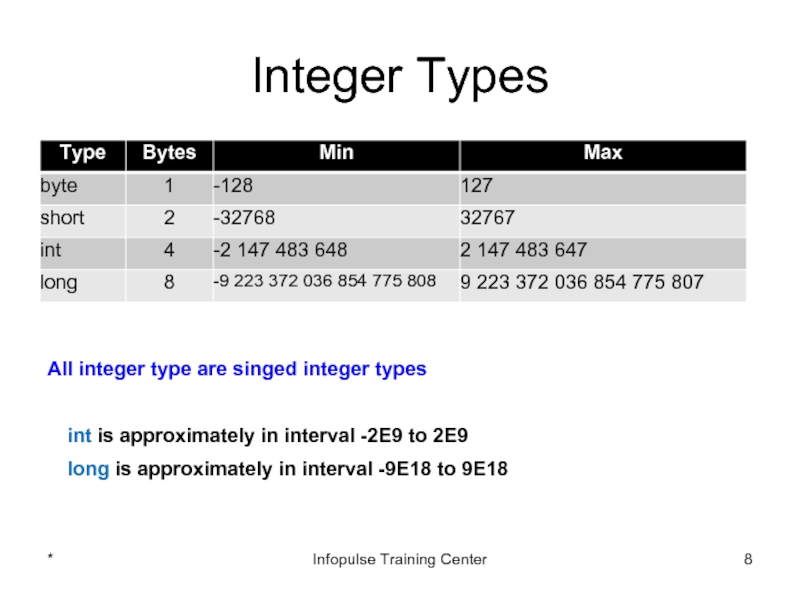
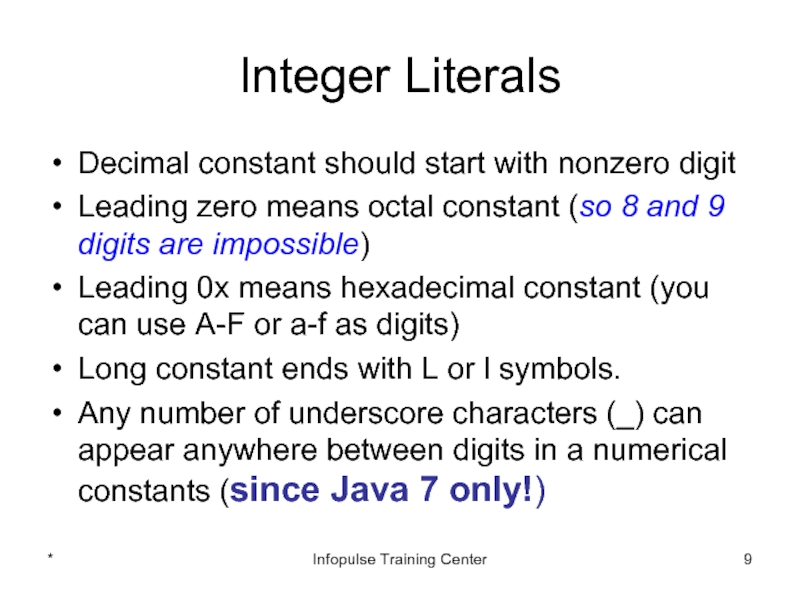
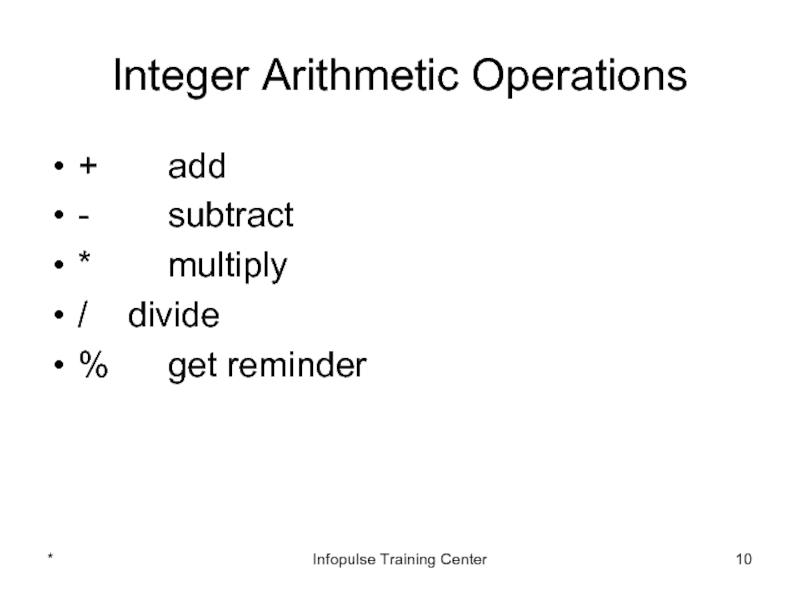
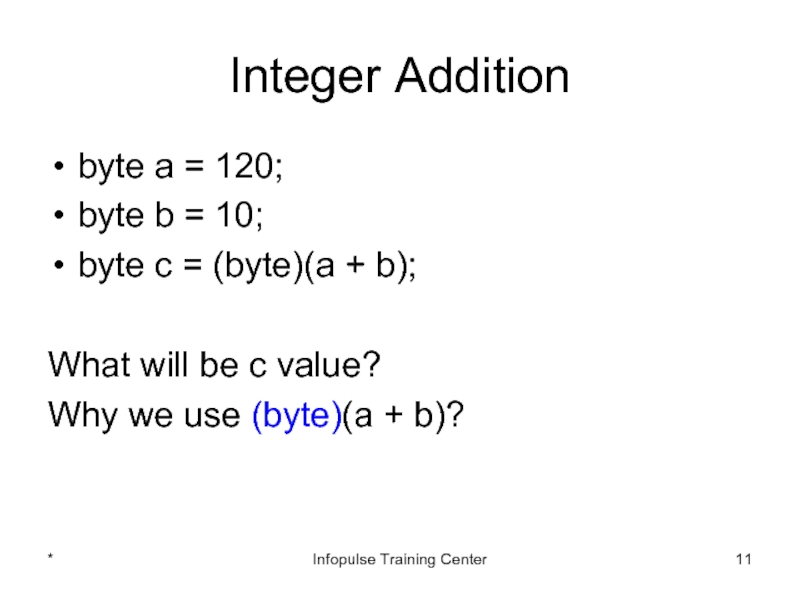

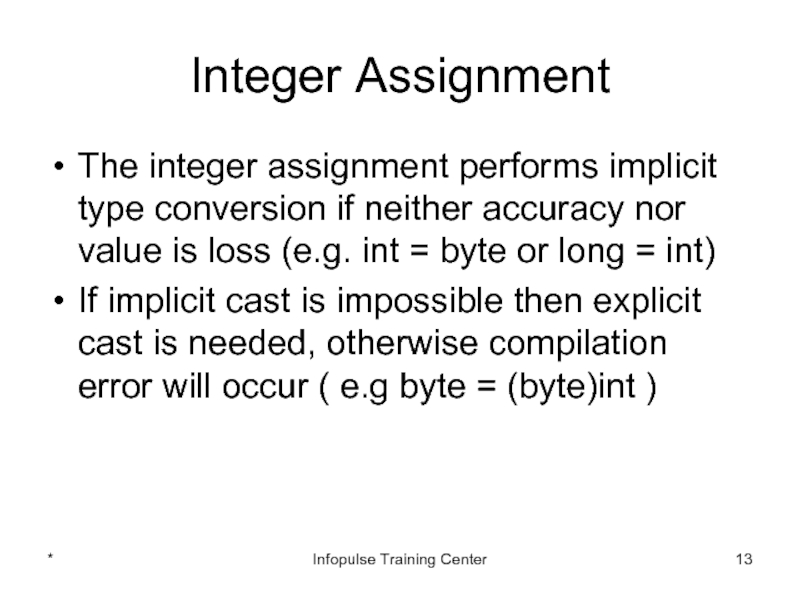
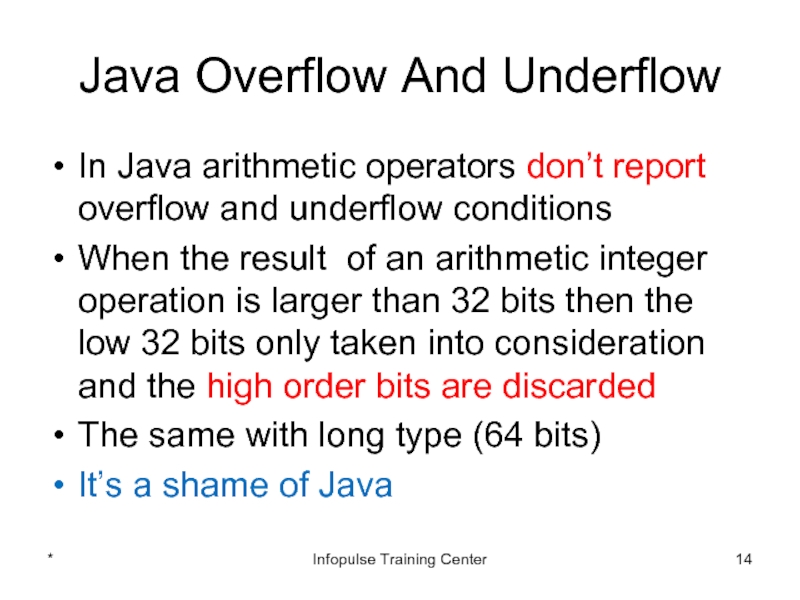

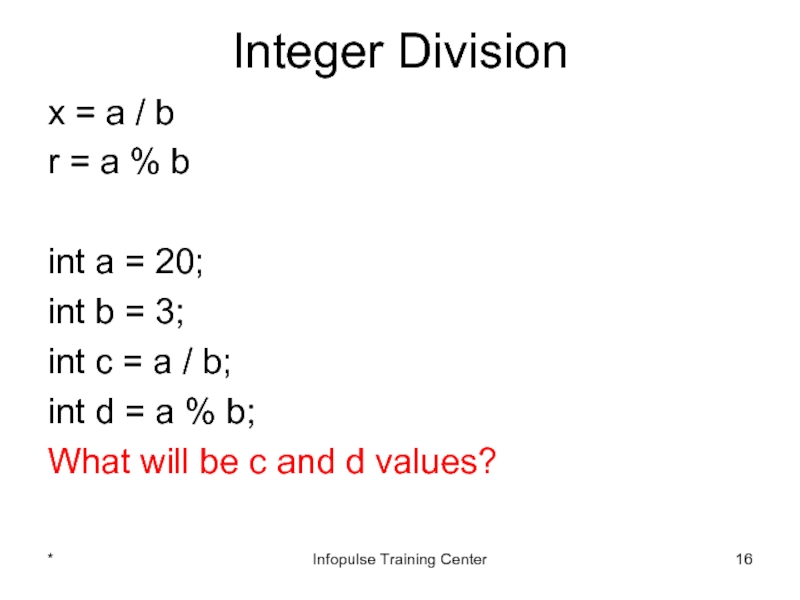
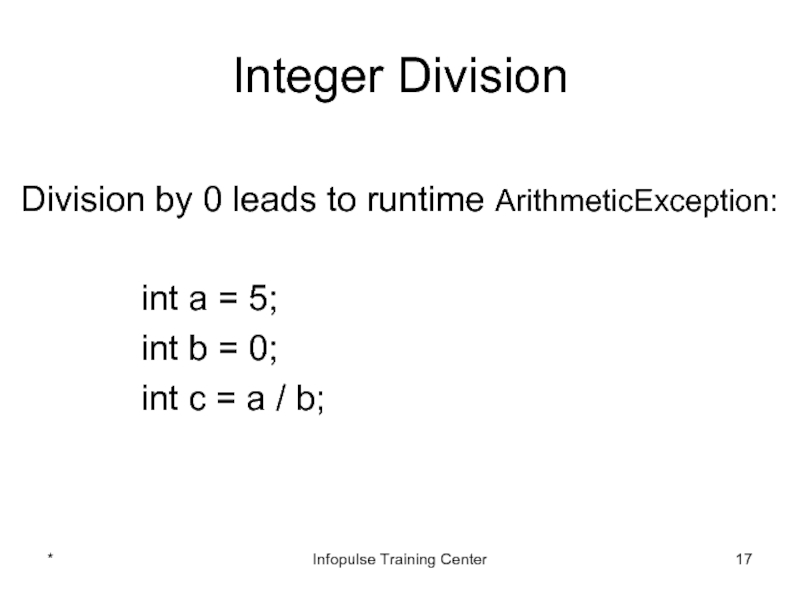
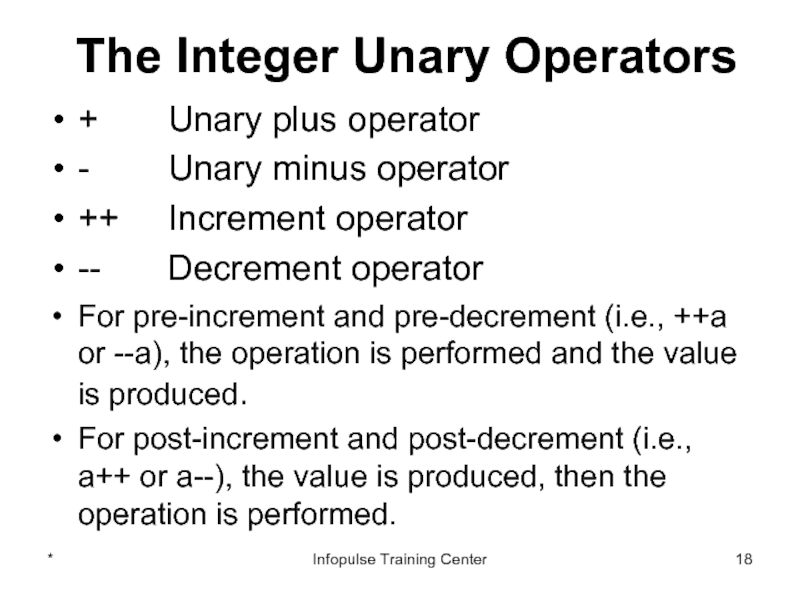

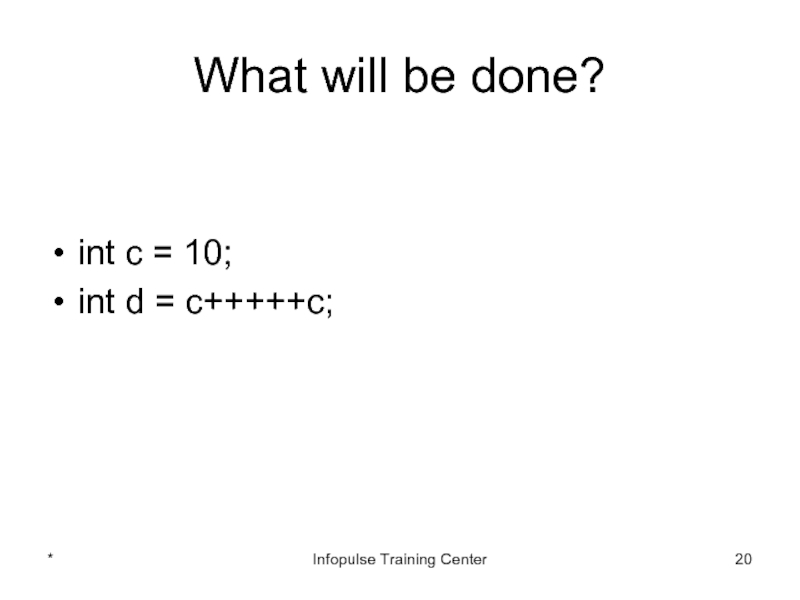
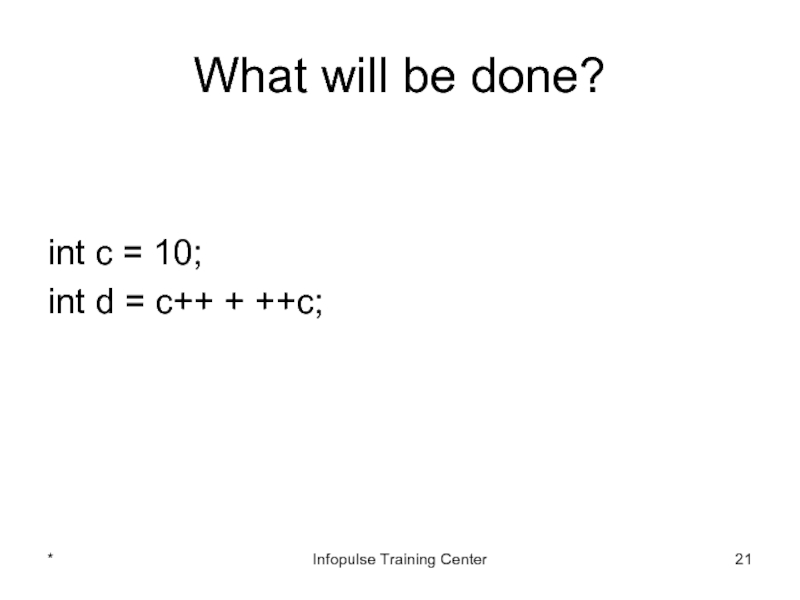
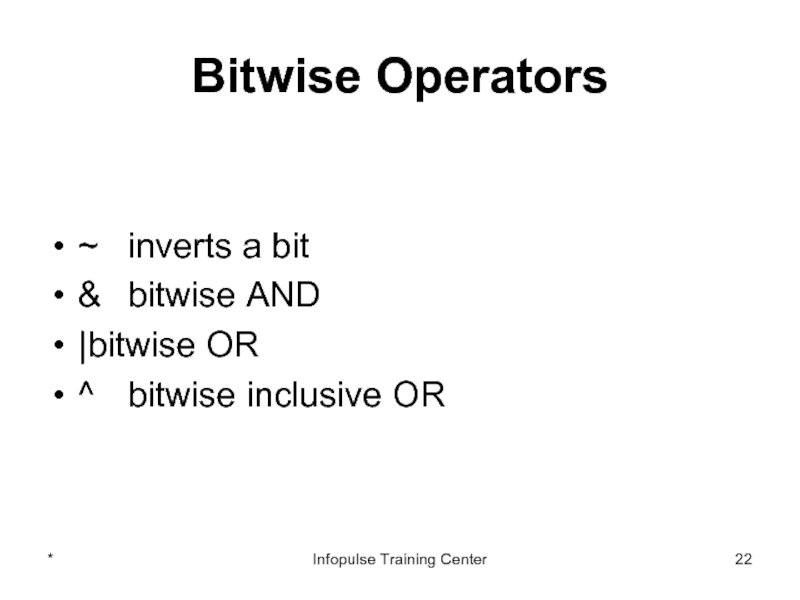
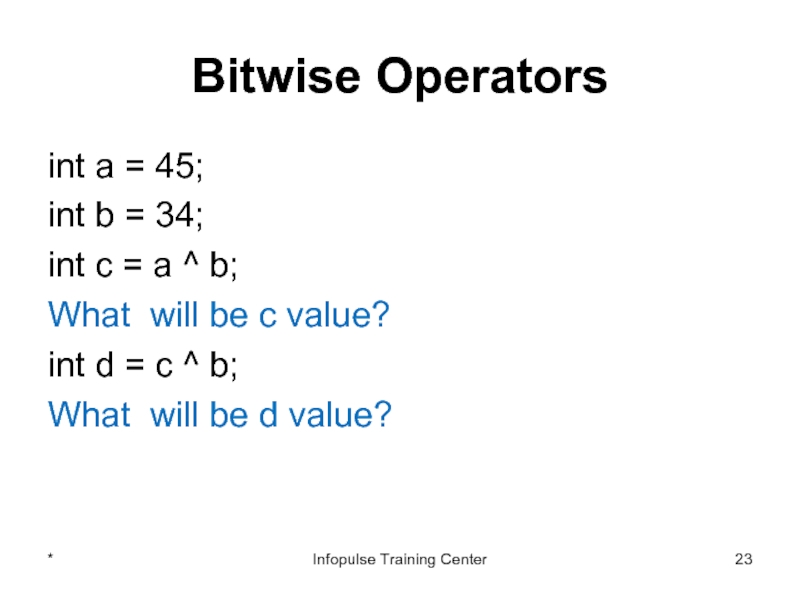
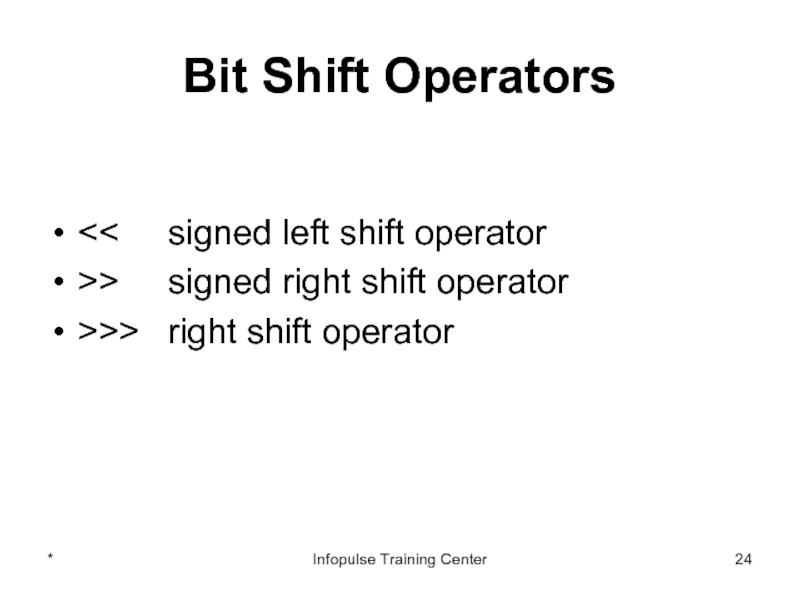


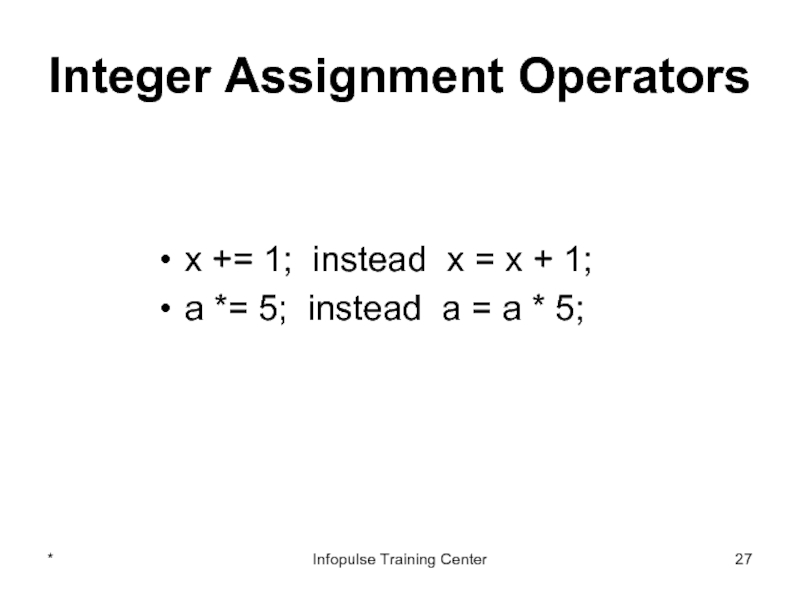
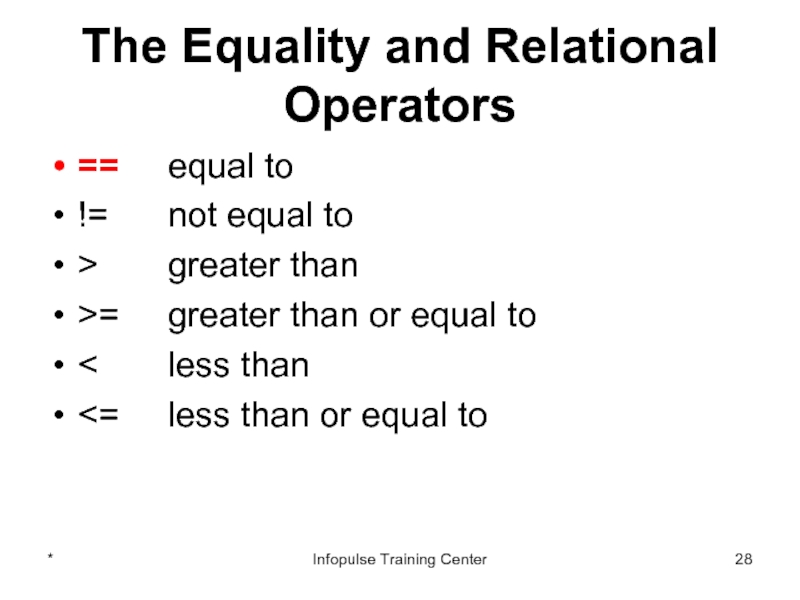
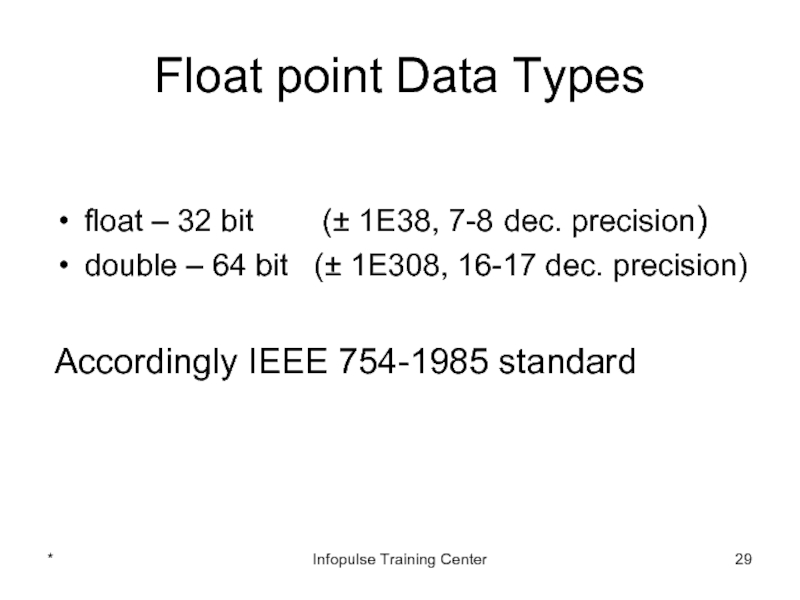
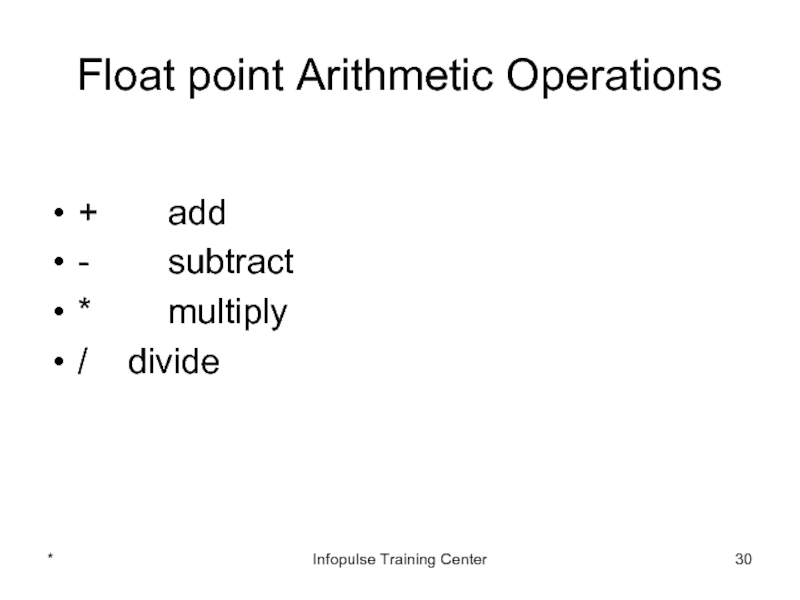
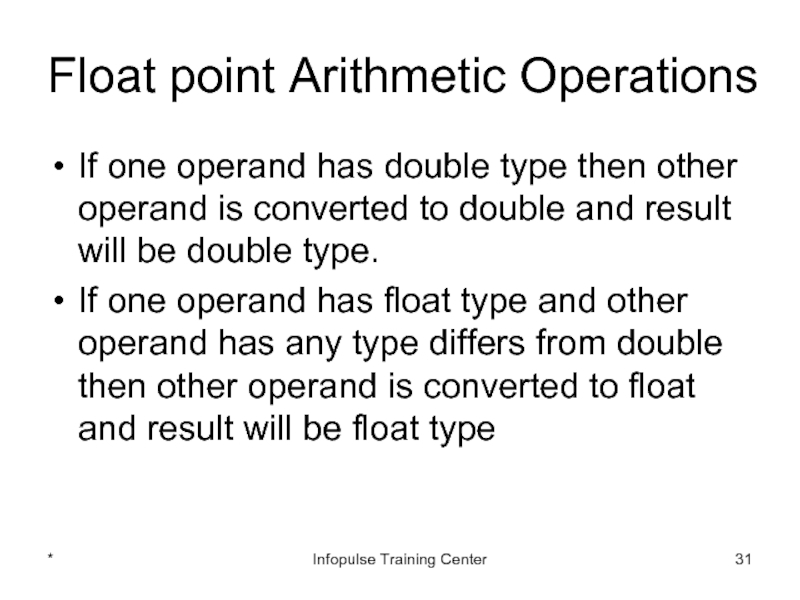

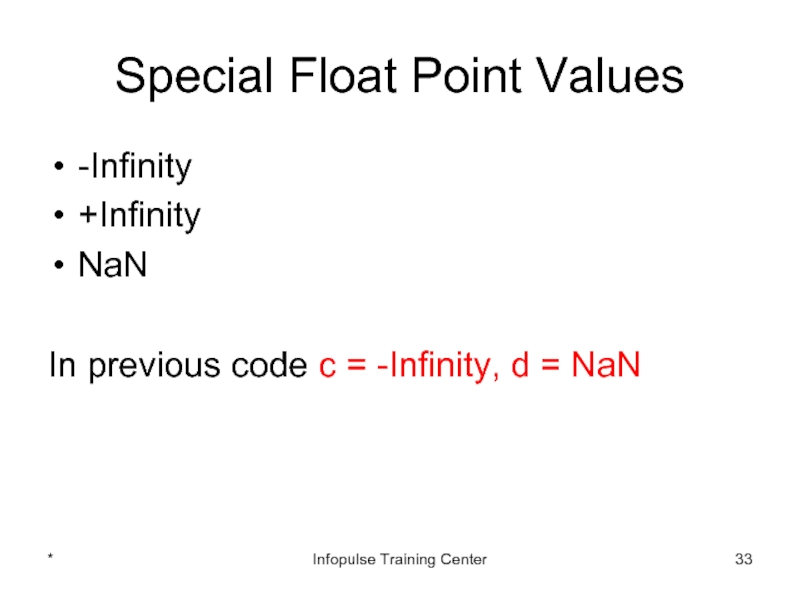
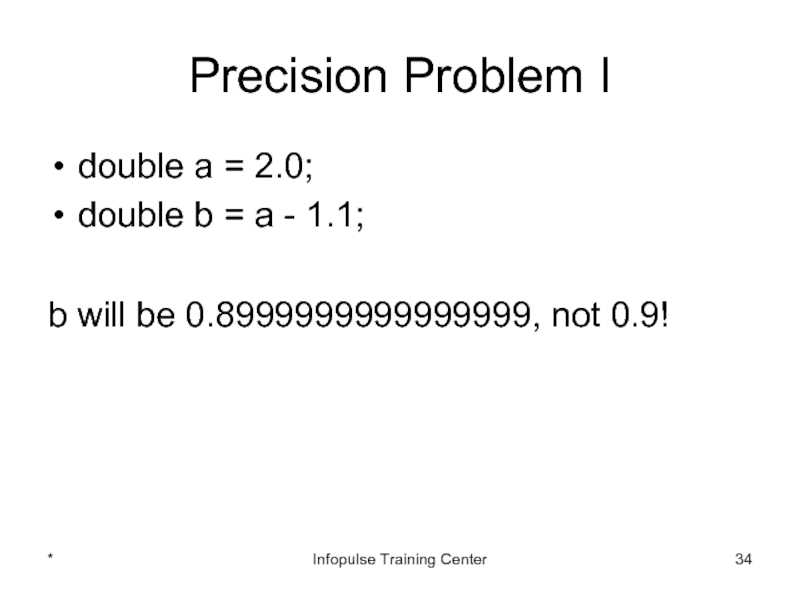
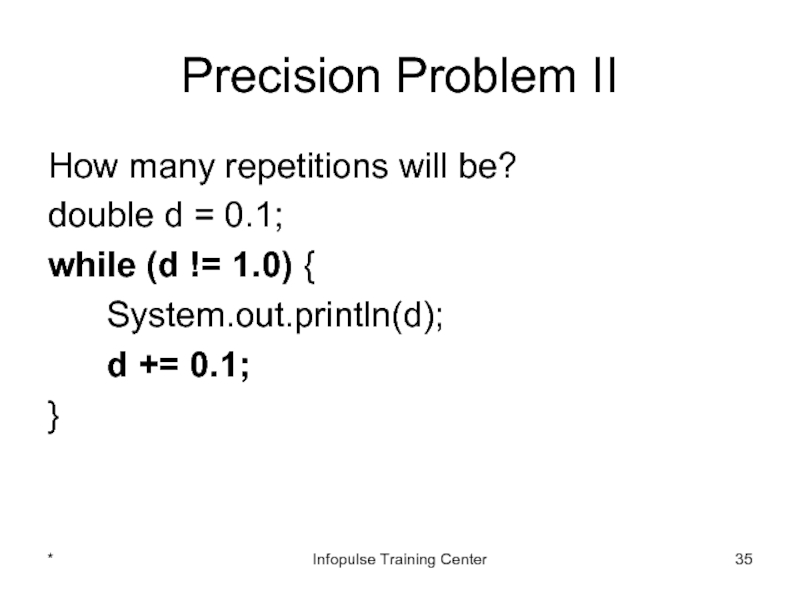
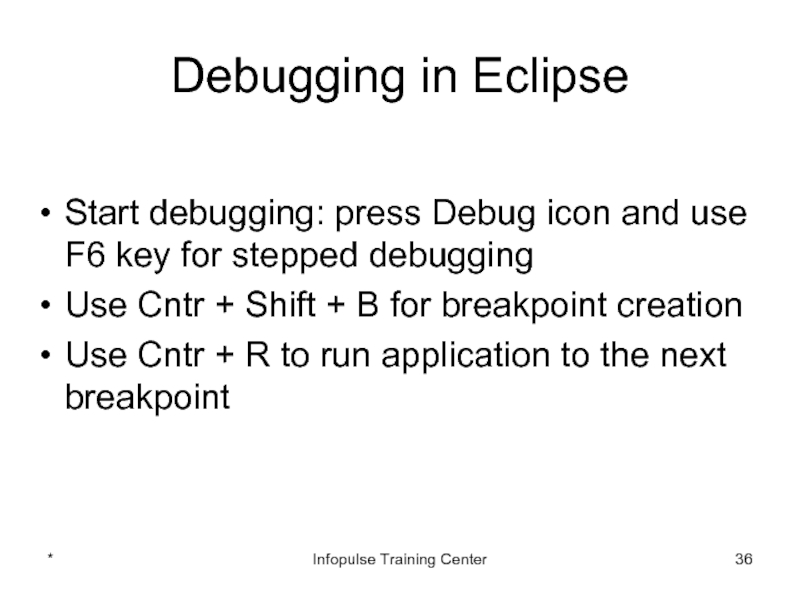
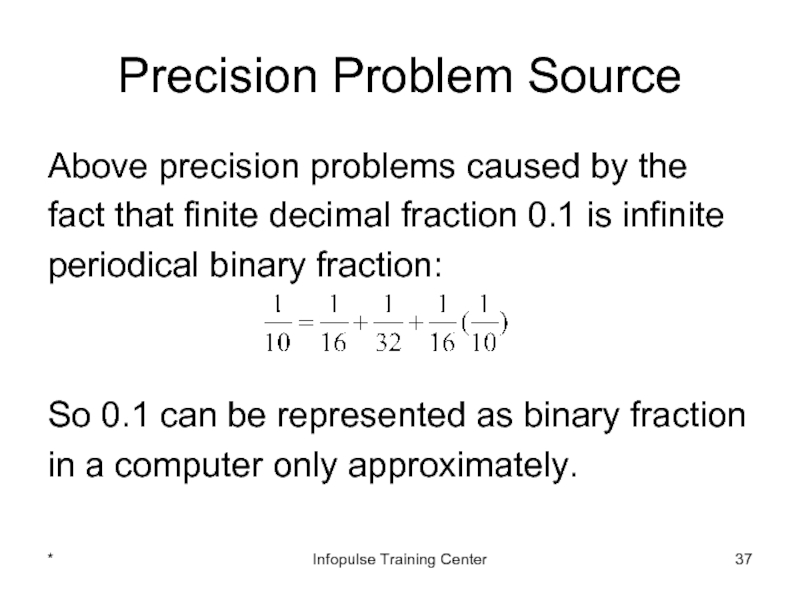
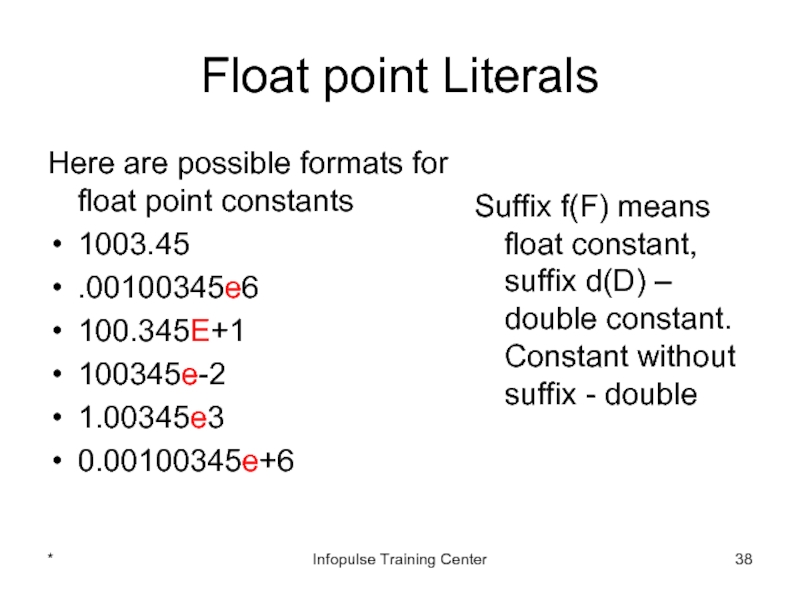
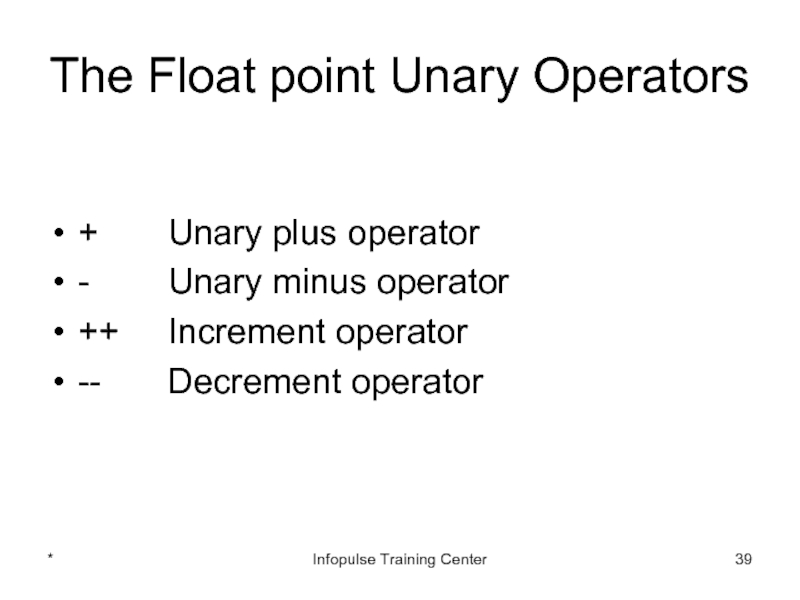
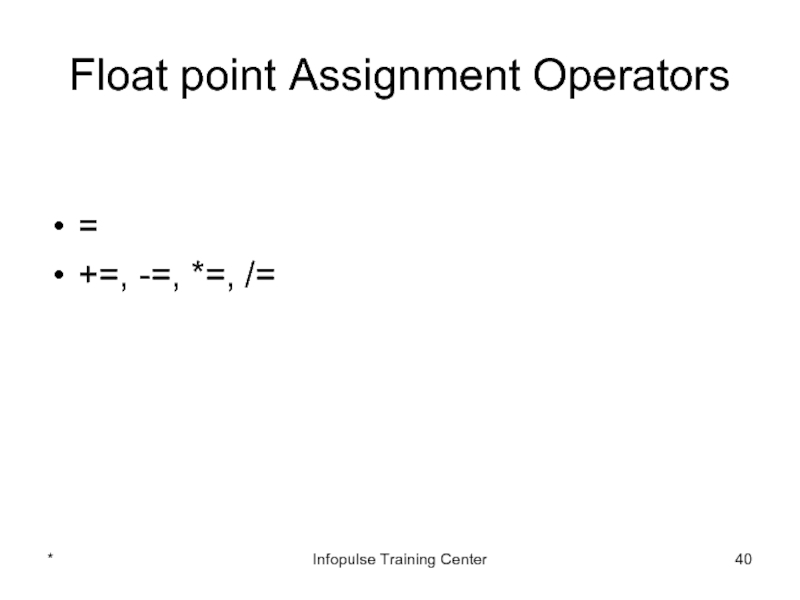
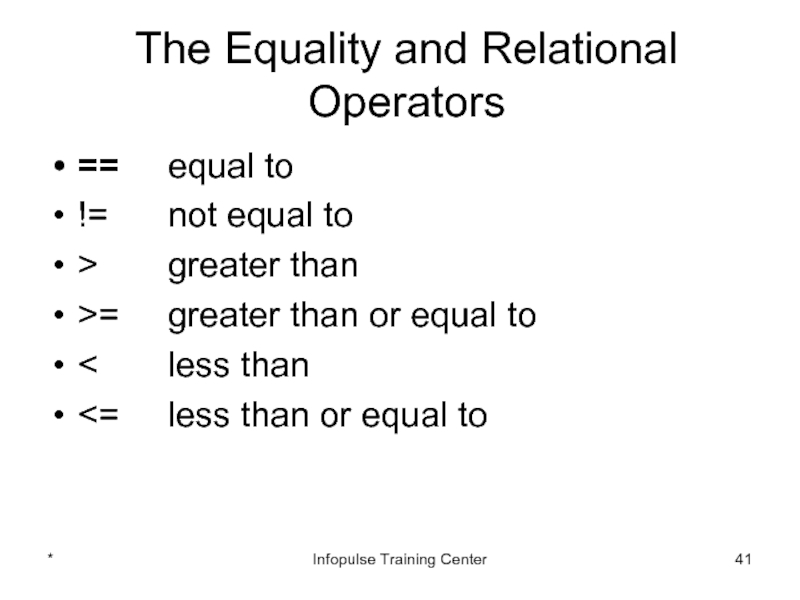
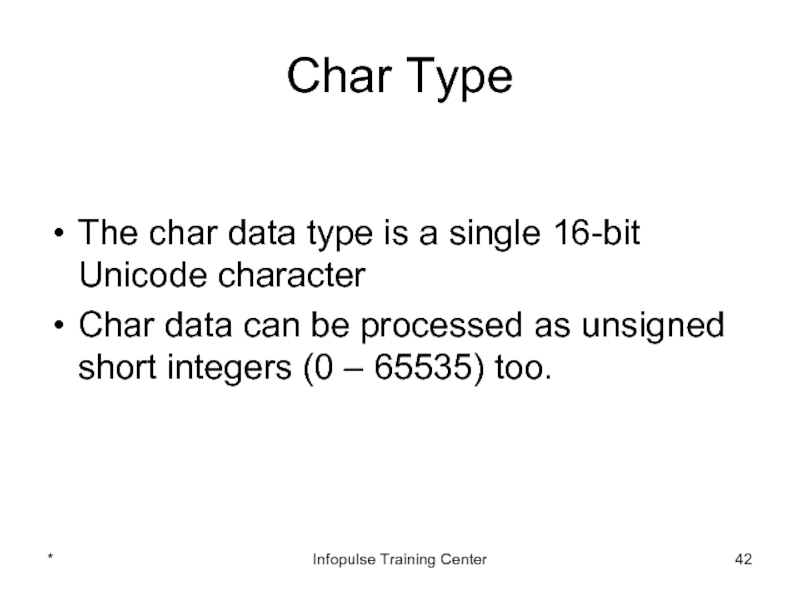
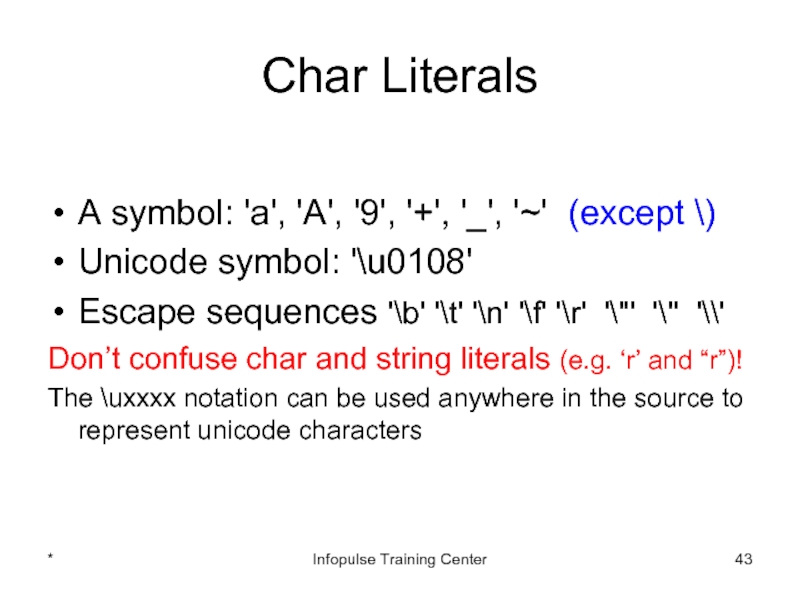

![Expressions. Operator precedence . [] () + - ~ !](/img/tmb/2/118900/d4520357e02b0e9bba0537d2c9a3694d-800x.jpg)
